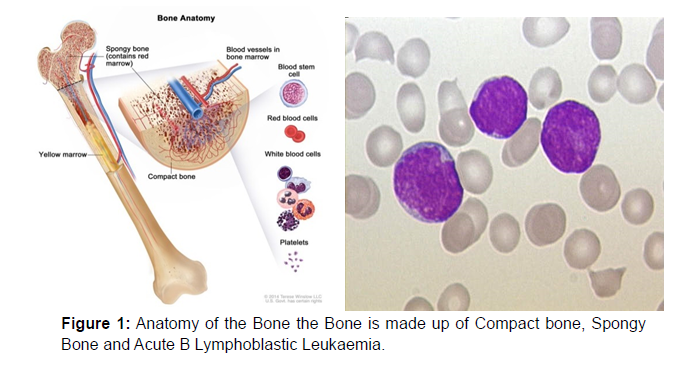Picture of Pidiatric B-Intense lymphoblastic leukaemia
Received: 23-Nov-2021 / Accepted Date: 30-Nov-2021 / Published Date: 07-Dec-2021 DOI: 10.4172/2167-7964.1000352
Image Article
B-Intense lymphoblastic leukaemia with intra cytoplasmic incorporations in lymph impacts is a surprising show. Here, we present a paediatric instance of rearrangement and uncommon impact morphology showing unmistakable intracytoplasmic eosinophilia considerations. The case is accounted for its uncommon event, particularly in youth and its perseverance in the post-acceptance marrow suction [1] which therefore showed helpless beginning treatment reaction notwithstanding the presence of good prognostic atomic markers. The current writing is surveyed (Figure 1).
Restoring ALL with chemotherapy requires a particular treatment approach that varies essentially from the standards of corrective treatment for hematologic malignancies. Drawn out openness to generally low single dosages of antimetabolites (bringing about high total portions of individual specialists) is the sign of paediatric-type ALL regimens. Most of the advancement in grown-up ALL as of late can be ascribed to the utilization of paediatric-type regimens to grown-up ALL patients, because of which 5-year endurance paces of half to 60% have been accomplished. The majority of these regimens are demonstrated on the Berlin-Frankfurt-Mã¼nster routine spine. The standards of such regimens, Grown-up type regimens, then again, are normally displayed after the hyper-CVAD routine (see the accompanying segment for particulars of this routine), which uses rotating patterns of dynamic specialists in higher individual portions that outcome in more myelo suppression. Acceptance cycles typically convey the most elevated danger of treatment-related complexities. Morphologic complete abatement is normally accomplished promptly, regardless of the routine utilized. Nonetheless, backslide stays normal in grown-ups and is the main source of mortality [2].
Bone marrow is a spongy material inside the bones that makes white platelets, red platelets, and platelets. With leukaemia the bone marrow makes white platelets that don’t work. These unusual cells can’t shield the body from microorganisms. They swarm the bone marrow, enter the circulatory system, and can spread to different pieces of the body, similar to the lymph hubs, cerebrum, or liver.
Everything is an infection of the bone marrow. Clinical doubt for all emerges with signs and side effects intelligent of bone marrow disappointment (pancytopenia) and additionally extra medullary sickness. The most well-known indications incorporate weariness, paleness, bone torment, joint inflammation, limping, simple swelling/ dying, or potentially petechial. Actual assessment might show lymphadenopathy and hepatic splenomegaly extra medullary inclusion might be found in the focal sensory system (CNS) with indications of expanded intracranial tension including cerebral pain [3].
lymphoblast’s are normally granular however a little rate might show numerous intracytoplasmic granules which show reactivity with vague esterase in granules and light dim staining with Sudan Dark B, not at all like the typical a granular lymphoblast’s A wide range of intra-cytoplasmic incorporations has been accounted for in lymphoblast’s including various round uniform PAS positive MPO negative intracytoplasmic considerations, MPO negative Auer pole like incorporations and Russel body like intracytoplasmic inclusions, Our case is accounted for its unmistakable trademark appearance and uncommon event exceptionally in adolescence, and its tirelessness in post-enlistment marrow suction, which additionally show edpoor reaction to treatment in the post-acceptance time frame, notwithstanding the presence of the great prognostic sub-atomic markers [3].
Imaging studies: These may include an X-ray, CT scan, MRI, or ultrasound. Doctors use these to rule out other causes of symptoms, or look for a mass of leukaemia cells in the chest that can affect breathing or blood circulation.
References
- Cecilie Utke Rank, Tobias W. Klausen, Henrik Birgens (2012) Adult acute lymphoblastic leukaemia in Denmark. A national population-based retrospective study on acute lymphoblastic leukaemia in Denmark 157:97-104.
- Denis Schewe, Mignon Loh, Rob Pieters, Martin Schrappe (2020) Acute Lymphoblastic Leukaemia 117-123.
- H. Josef Vormoor, Tobias F. Menne, Anthony V (2020) Moorman Acute lymphoblastic leukaemia, 5269-5280.
Citation: Robert C (2021) Picture of Pidiatric B-Intense lymphoblastic leukaemia. OMICS J Radiol 10: 352. DOI: 10.4172/2167-7964.1000352
Copyright: © 2021 Robert C. This is an open-access article distributed under the terms of the Creative Commons Attribution License, which permits unrestricted use, distribution, and reproduction in any medium, provided the original author and source are credited.
Select your language of interest to view the total content in your interested language
Share This Article
Open Access Journals
Article Tools
Article Usage
- Total views: 2373
- [From(publication date): 0-2021 - Nov 22, 2025]
- Breakdown by view type
- HTML page views: 1674
- PDF downloads: 699

